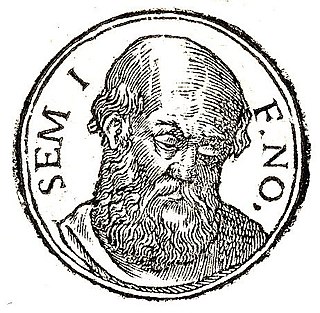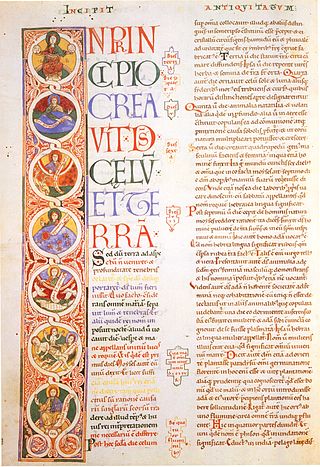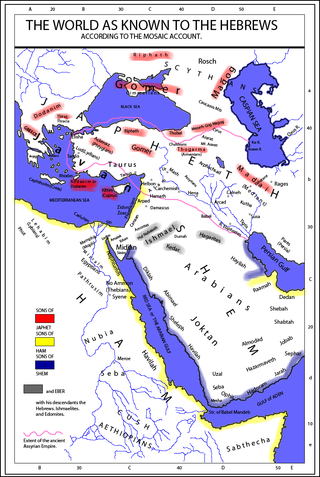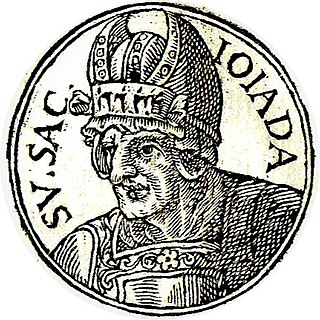Related Research Articles

The first-century Jewish historian Flavius Josephus provides external information on some people and events found in the New Testament. The extant manuscripts of Josephus' book Antiquities of the Jews, written around AD 93–94, contain two references to Jesus of Nazareth and one reference to John the Baptist.

Flavius Josephus or Yosef ben Mattityahu was a Roman–Jewish historian and military leader. Best known for writing The Jewish War, he was born in Jerusalem—then part of the Roman province of Judea—to a father of priestly descent and a mother who claimed royal ancestry.

Shem is one of the sons of Noah in the Bible.
The Sadducees were a sect of Jews active in Judea during the Second Temple period, from the second century BCE to the destruction of the Second Temple in 70 CE. The Sadducees are described in contemporary literary sources in contrast to the two other major sects at the time, the Pharisees and the Essenes.

William Whiston was an English theologian, historian, natural philosopher, and mathematician, a leading figure in the popularisation of the ideas of Isaac Newton. He is now probably best known for helping to instigate the Longitude Act in 1714 and his important translations of the Antiquities of the Jews and other works by Josephus. He was a prominent exponent of Arianism and wrote A New Theory of the Earth.

Amon of Judah was the fifteenth King of Judah who, according to the biblical account, succeeded his father Manasseh of Judah. Amon is most remembered for his idolatrous practices during his short two-year reign, which led to a revolt against him and eventually to his assassination in c. 641 BC.

Antiquities of the Jews is a 20-volume historiographical work, written in Greek, by historian Josephus in the 13th year of the reign of Roman emperor Domitian, which was 94 CE. The book contains an account of the history of the Jewish people for Josephus's gentile patrons. In the first ten volumes, Josephus follows the events of the Hebrew Bible beginning with the creation of Adam and Eve.

The Jewish War is a work of Jewish history written by Josephus, a first-century Roman-Jewish historian. It has been described by the historian Steve Mason as "perhaps the most influential non-biblical text of Western history".

The siege of Jerusalem of 70 CE was the decisive event of the First Jewish–Roman War, in which the Roman army led by future emperor Titus besieged Jerusalem, the center of Jewish rebel resistance in the Roman province of Judaea. Following a five-month siege, the Romans destroyed the city, including the Second Jewish Temple.

Kittim was a settlement in present-day Larnaca on the east coast of Cyprus, known in ancient times as Kition, or Citium. On this basis, the whole island became known as "Kittim" in Hebrew, including the Hebrew Bible. However the name seems to have been employed with some flexibility in Hebrew literature. It was often applied to all the Aegean islands and even to "the W[est] in general, but esp[ecially] the seafaring W[est]". Flavius Josephus records in his Antiquities of the Jews that

Matthew 3:5 is the fifth verse of the third chapter of the Gospel of Matthew in the New Testament. The verse occurs in the section introducing John the Baptist with this verse describing his popularity in the region.
Justus of Tiberias was a 1st century Jewish author and historiographer. All that we know of his life comes from the Vita which Flavius Josephus apparently wrote in response to the assertions made by Justus in his History of the Jewish War, published around 93/94 or shortly after 100. Josephus is moreover the only writer to mention this document, but without ever citing the slightest extract. This History published by Justus seems to have disappeared shortly after the publication of the Autobiography of Flavius Josephus, because it is unknown to pagan authors and the Christian authors who mention it only quote what Josephus said.
Gessius Florus was the 7th Roman procurator of Judea from 64 until 66.

Simeon the Righteous or Simeon the Just was a Jewish High Priest during the Second Temple period. He is also referred to in the Mishnah, where he is described as one of the last members of the Great Assembly.

Jehoiada in the Hebrew Bible, was a prominent priest in the kingdom of Judah during the reigns of Ahaziah, Athaliah, and Joash. Jehoiada became the brother-in-law of King Ahaziah as a result of his marriage with princess Jehosheba. Both Jehosheba and Ahaziah were children of King Jehoram of Judah. Ahaziah died a year after assuming the throne, which was then usurped by his mother Athaliah, who ordered the execution of all members of the royal family.
Lucceius Albinus was the 6th Roman Procurator of Judea from 62 until 64 and the governor of Mauretania Tingitana from 64 until 69.
Caius, Presbyter of Rome was a Christian author who lived and wrote towards the beginning of the 3rd century. Only fragments of his works are known, which are given in the collection entitled The Ante-Nicene Fathers. However, the Muratorian fragment, an early attempt to establish the canon of the New Testament, is often attributed to Caius and is included in that collection.

The Slavonic Josephus is an Old East Slavic translation of Flavius Josephus' History of the Jewish War which contains numerous interpolations and omissions that set it apart from all other known versions of Josephus' History. The authenticity of the interpolations was a major subject of controversy in the 20th century, but the latest scholarship has rejected them.

Livias was a city in Transjordan in Classical Antiquity. In the writings of Josephus (English translation), the name is presented as Julias.
Pleistoros was, according to Herodotus, a Thracian god adored by the Gauls and the tribe "Absinthe" (Apsintieni) as the god of war. According to Josephus Flavius. Pleistoros was the god of war Dacians pleistoi, to which these Thracians offered sacrifices of men. The priests were recruited between nobles, some of whom are warriors.
References
- 1 2 Flavius Josephus. "The Works of Flavius Josephus" (PDF). Ultimate Bible Reference Library. Translated by William Whiston. Archived from the original (PDF) on 2018-10-13. Retrieved 2018-10-13.
- ↑ Flavius Josephus. William Whiston (ed.). "The Life of Flavius Josephus". Persius Digital Library. Retrieved 2022-07-06.
- ↑ Chajes, Hirsch Perez. "Beiträge zur Nord-Semitischen Onomatologie". Europeana Collections (Catalogue record) (in German and English). p. 13. Archived from the original on 2018-10-13. Retrieved 2018-10-13.
- ↑ Richard Gottheil; Samuel Krauss (1906). "Banus". Jewish Encyclopedia. Retrieved 2018-10-13.